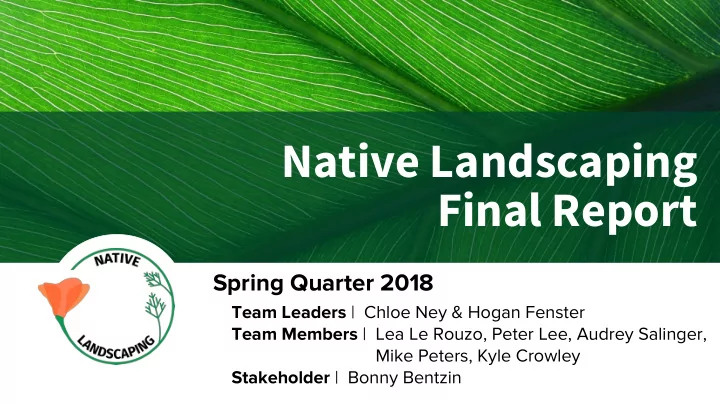

Native Landscaping Final Report Spring Quarter 2018 Team Leaders | Chloe Ney & Hogan Fenster Team Members | Lea Le Rouzo, Peter Lee, Audrey Salinger, Mike Peters, Kyle Crowley Stakeholder | Bonny Bentzin
RESEARCH QUESTION How do we incorporate more native landscaping into current campus landscaping practices?
Goals Short term goals ● Provide the opportunity for interdisciplinary education on outdoor spaces at UCLA ● Improve underutilized spaces on campus with functional landscaping Long term goals ● Improve campus ecology and biodiversity ● Reach UCLA’s Carbon Neutral Initiative Goal By 2025 ● UCLA as a model for ecologically sound urban landscaping
Three Pronged Approach Map & Survey Outreach Palette
Outreach — Methodology Key informant interviews ● Cully Nordby, Tom Gillespie, Nurit Katz, Alison Lipman, Stephanie Landregan, Lisa Novick, Wayne Dollase ○ Create a more thriving, biodiverse ecosystems by incorporating natives ○ Ensure UCLA will intend to plant non-invasive plants as lawn areas are transformed ○ Promote education through purposeful landscaping
Outreach — Methodology Outreach Interviews Chico State, Stanford University, Santa Monica College, UC Santa Barbara ● UCLA can benefit from space-based planting and using green spaces for ○ education Natives must be incorporated gradually and based on location, rigid guidelines ○ are constricting Stakeholder, Capital Programs, Facilities Meetings UCLA is already moving towards integrating natives and drought-tolerant landscaping ● UCLA stakeholders should review pallets and guidelines as underutilized spaces ○ are transformed Minimize pesticide use, mowing, watering, maintaining, polluting (exhaust) ○
Survey — Methodology Survey based on key informant interviews and ● from UC Stormwater Initiative Survey ● Filled out by a variety of 81 community members, spanning 33 majors/departments Gauged knowledge of native plants ● ● Determined preferences/priorities for landscaping
Survey — Results Functionality ● The survey helped demonstrate the clear demand for functional landscaping over aesthetics Respondents wanted to see more trees ● and areas that provide shade to facilitate working outside on laptops
Survey — Results Funding Native Landscape Perception People are willing to pay to People could identify native plants ● ● make sure this happens! with a 52.4% accuracy ✅ ✅ *In addition to TGIF ✅ ✅
Native Plant Preferences
Palette — Methodology Local California Native Plants ● ● Focus on UCLA microclimates Looked at Santa Monica Community College, Theodore Payne ● Foundation, and Sustainable Landscape Case Study
Palette — Results 100+ choices for shrubs, grasses, and trees in the 90095 zip code ● alone ● 50% biomass of native plants
Map — Results
Conclusion Recommendations Enforce 50% native/50% non-native biomass rule on future projects ● ● Proceed with consistent landscape architect/landscaping task-force committee meetings and review Future SAR projects: conduct cost-benefit analysis on water usage ● and maintenance
We would like to thank... Bonny Bentzin Chris Gallego Gregory Pierce & & Nurit Katz & Raul Kelsey Jessup Our stakeholders who At Facilities Management At the Luskin Center who provided us guidance and who offered us on-site guided us through the valuable contacts. information. survey process. The Green Initiative Capital Programs Lisa Novick Fund For providing us with maps For providing us with and GIS data. invaluable information on For providing us funds for native plants. Earth Day and Survey Efforts.
Thanks! Any comments, questions, or concerns?
Recommend
More recommend